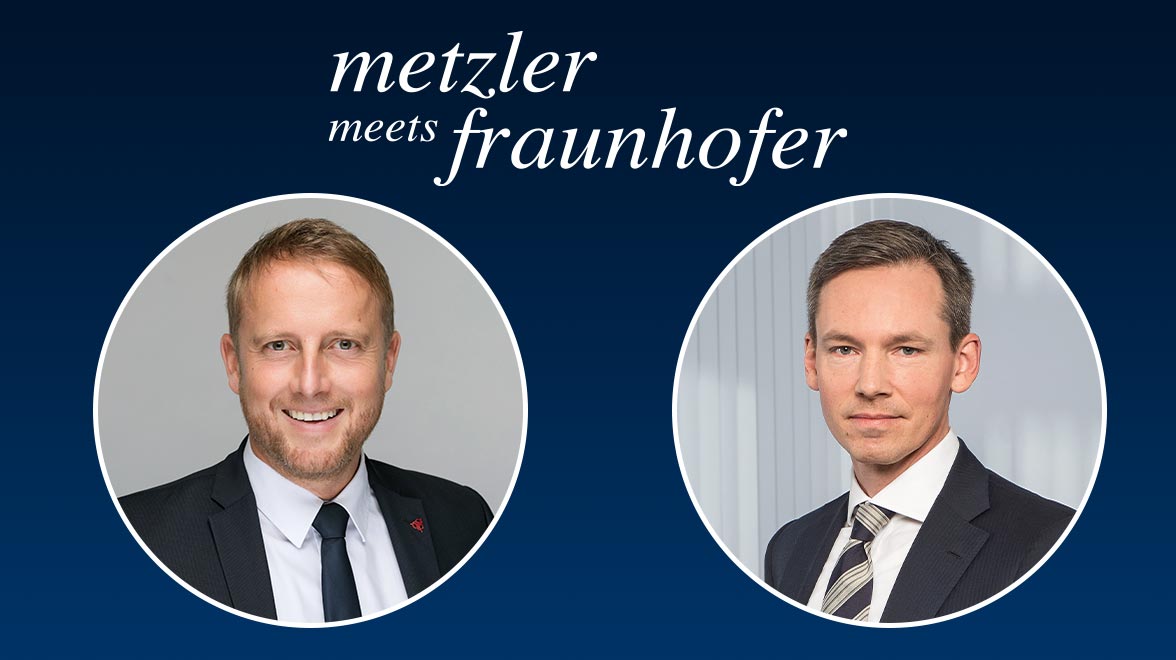The hype is over – AI is here

Generative AI has arrived – and is here to stay. Researchers are working intensively on the topic and industry is exploring use cases. It is becoming apparent that the new AI technology could lead to a boost in production in the economy. In almost all sectors, there seem to be virtually no limits to the imagination about the possible use of AI. Pascal Spano, Head of Research at Metzler Capital Markets, met with Dr. Dirk Hecker, Deputy Director of the Fraunhofer Institute for Intelligent Analysis and Information Systems IAIS, to discuss AI, specific applications and the technology's potential and challenges.
Pascal Spano: Dr. Hecker, a good 18 months ago, ChatGPT experienced a meteoric rise and since then nobody has been able to avoid the topic of AI. How big is the hype factor?
Dirk Hecker: Generative AI actually reached the top of the Gartner hype cycle a year ago. And not without good reason, as the new models can solve a completely new class of tasks and thus support developers, creatives and knowledge workers to an unprecedented extent.
Spano: Unlike previous hype topics, fields of application are emerging at record speed with AI. Do you share this observation?
Hecker: The hype is over, AI is here! One unmistakable sign of this is NVIDIA shares, whose stock market value has seen incredible leaps in recent months and has just reached a new high in June. NVIDIA is currently the most valuable company in the world. This is due to the high demand for computing capacity, which means that many more AI models will be trained and used in the future.
However, it must also be said that AI has not just been “here” since the hype surrounding ChatGPT. We at Fraunhofer IAIS have also been working for many years on artificial intelligence technologies that are used by our customers around the clock, seven days a week, to support people in their work. With the rapid development of generative AI and the necessary computing resources, we have now arrived in a new era of AI that will permeate all areas of our economy and society far beyond the hype.
Spano: How does generative AI differ from other areas of AI research?
Hecker: Traditional AI approaches such as supervised machine learning and pattern recognition are suitable for tasks such as classification, prediction and suggestion. For each new question, however, an individual model must be trained with specific sample data. A notorious bottleneck here is the sample data, which usually has to be annotated by humans beforehand in order to make it available to the model as training examples.
Generative AI does not have this problem. It learns in a self-monitoring manner by predicting self-generated gaps in the data, such as individual words, and comparing them with the retained information. This means that the entire internet and its data are suddenly available as learning material. A model trained in this way can solve an astonishing number of tasks and is therefore very versatile. This is why the models are also called foundation models. They not only master analytical tasks, they also generate new content: there are now multimodal, multilingual models that can generate content such as texts and code, speech and music, images and video clips in many languages.
Such reusable models radically change the previous set-up times for the development of AI systems, as a fundamental model can be used much more comprehensively, cost-effectively and efficiently and usually only requires minor adjustments for different purposes.
Spano: US tech companies dominate AI development. How far behind are Germany and Europe?
Hecker: The development of large generative models is very expensive – the GPT4 model reportedly cost well over 100 million US dollars. The market is dominated by the large US tech companies that can finance, or rather pre-finance, the computing power and the procurement of more and more new data. Their best models remain closed to us and European companies can only use them via the services. This means that our data goes to the servers of US tech companies and is used to continuously improve the models.
Spano: Approximately how high is the investment volume in AI models?
Hecker: According to the Stanford AI Index Report 2023, 51 of the most important models come from industry and only 15 from public research. Private investment in the USA rose by 22.1 percent to 67.2 billion US dollars in the reporting year, while in Europe it shrank by 14.1 percent to 11 billion US dollars.
Spano: These figures are not very encouraging from a European perspective. So what can we do to avoid once again being left behind by the USA in a key digital competence?
Hecker: We have to work very hard not to lose touch. That's why we in Germany and Europe are working on intensifying research funding in the field of generative AI alongside private-sector investment and aligning our GenAI research with the needs of German and European companies in particular. In the “OpenGPT-X” project funded by the Federal Ministry for Economic Affairs and Energy, we are currently training large language models with the aim of making them available as open source and adapting them flexibly to the individual needs of companies. It is also important that we invest in the infrastructure in order to be able to calculate large European models and give companies more freedom of choice for their GenAI applications through a variety of available models.
Spano: What progress do you expect to see in generative AI over the next few years?
Hecker: Generative AI provides us with a powerful tool that opens up, processes and applies collective knowledge ready for use. We will soon be able to talk to our devices, personalized co-pilots will support us in every app, autonomous agents will take over our jobs and cobots will find their way around our world better and better. I expect that models will not only become even more intelligent and versatile in the future, but also more specialized, smaller, more energy-efficient and more cost-effective for certain areas of application. It will be important for us to keep pace with developments and not become completely dependent on high-tech and high-investment countries such as the USA. We should master the technology to such an extent that we can offer our own products to our economy in particular, which are characterized by specialist knowledge and are based on European values.
Spano: In which sectors do you see the greatest potential for the use of AI?
Hecker: In almost all sectors, we are facing a huge problem due to the demographic shortage of skilled workers. This can be mitigated by generative AI. The prerequisite for this is a stringent digitalization of processes. But this can also be improved more than ever with generative AI. I'm thinking of the effort involved in creating documentation, filling out forms and recording conversations. Generative AI can not only relieve us of these text productions, it can also check, search, interpret, evaluate, summarize and assess the texts. I see particular potential here in the healthcare sector, in the legal sector and generally in all administrative areas.
Spano: Where there is a lot of light, there is no shortage of shadow – what are the dangers of AI?
Hecker: We can already see the biggest dangers: misuse of the technology, lack of reliability of the results or careless handling of intellectual property. Generative AI makes it easier to create deep fakes, attack digital systems and deceive people by using false identities. We must be able to understand how content is created and recognize and prevent misuse as it arises. AI must be reliable in the sense that it delivers correct or balanced results when used properly. The training data must be balanced. The AI must state its sources correctly and verifiably and preferably check them itself. It must relativize uncertain statements. The more we rely on the AI, the more we need to do this. The handling of third-party data is an open problem. Personal data must be protected, it must be possible to exclude data in the network from training and external sources that are used must be licensed or appropriately remunerated.
Spano: What role does human supervision and control play in the use of generative AI, especially with regard to avoiding errors or undesirable results?
Hecker: Four eyes see more than two. Whether and when an AI is allowed to make independent decisions at all is regulated by various laws – for example in the healthcare sector, in transportation and, in particular, by the EU's new upcoming AI regulation. The AI should be as reliable as possible, for example by providing transparent sources and alternatives. Another key factor is the software in which the AI model is embedded. The design of the human-machine interaction should reinforce a vigilant and critical attitude among users. Results should therefore be critically examined even if the AI has otherwise always delivered very reliably and humans are under time pressure.
Spano: What recommendations would you give to companies that want to integrate generative AI into their operations?
Hecker: We advise our customers: Take a step-by-step approach. Test to see how far you can get with prompts. There are particular benefits if the AI can access company knowledge and data, but data protection must of course be handled very carefully here. In a second step, consider connecting the AI to your company's information systems before you retrain and specialize a model with company-specific data. Compare different models using benchmarks that reflect your tasks or, even better, with your own test data. Consider whether an open model that can be operated in the EU is suitable. And use AI internally first before offering it to your customers.
Spano: What should be considered in order to avoid risks when introducing AI?
Hecker: Risks arise if there are no rules on how employees are allowed to use AI. Establish clear guidelines as to which tasks are assigned to the AI and which data may be transmitted for this purpose. And make sure that employees do not use public AI services with private accounts in the absence of alternatives authorized by the company.
Spano: With the EU AI Act, the European Union is a global pioneer in the regulation of technology. How do you rate the EU AI Act?
Hecker: First of all, it is a success that we managed to adopt a uniform regulation for the use of AI in 27 member states before the European elections. Imagine if we had individual national regulations – that would be an unmanageable bureaucratic and regulatory burden for companies, start-ups, etc. The EU's AI Act categorizes and regulates AI applications according to their risk potential. This fits well with the test catalog that Fraunhofer IAIS has developed for trustworthy AI – as a guide to systematic risk assessment, with suggestions for risk reduction and with an overview of tools and metrics for automating testing and monitoring. In the last phase of the AI Act, the law was also extended to generative AI, whose models are now referred to as 'General Purpose AI Models' (GPAI Models). Here, the obligations for open and closed models differ and depend on the computational effort involved in training.
Spano: So nothing stands in the way of the development of AI innovations in Europe with the EU AI Act?
Hecker: Whether the law achieves its goal of promoting innovation with trustworthy AI in Europe now depends largely on the upcoming implementation in Europe and the individual countries. Companies have a two-year transition period to adapt to the new regulation. Our Innovation Briefing on the operationalization of the AI Act provides an overview of the requirements and core elements of the AI regulation. It also shows how to translate regulatory requirements into business processes and implement them in a scalable way in technical development environments. My advice here is to get to grips with the AI Act in the coming months, because its implementation will require new processes in the company – but it will be worthwhile to embark on the path to “Trustworthy AI made in Europe”, I am sure of that.
Spano: Thank you very much for the interview.

Dr. rer. nat. Dirk Hecker is Deputy Director of the Fraunhofer Institute for Intelligent Analysis and Information Systems (IAIS) in Sankt Augustin. His research interests include big data analytics, deep learning and generative AI and he is Managing Director of the Fraunhofer Alliance for Big Data and Artificial Intelligence.

Pascal Spano is Head of Research in the business area Capital Markets. Before joining Metzler, he was Managing Director of the FinTech company PASST Digital Services GmbH in Cologne, which he co-founded. His other professional experience includes UniCredit Group, Credit Suisse Ltd, Deutsche Bank and ABN Amro. He has been a member of the German Society for Financial Analysis for around 20 years.
 Deutsch
Deutsch English
English